Many caravanners find the use of a motor mover makes the task of manoeuvring their caravan for hitching up, placing on site and moving around a storage area so much easier.
Benefit from expert advice, retail discounts and money off pitch night stays when you join the Club.
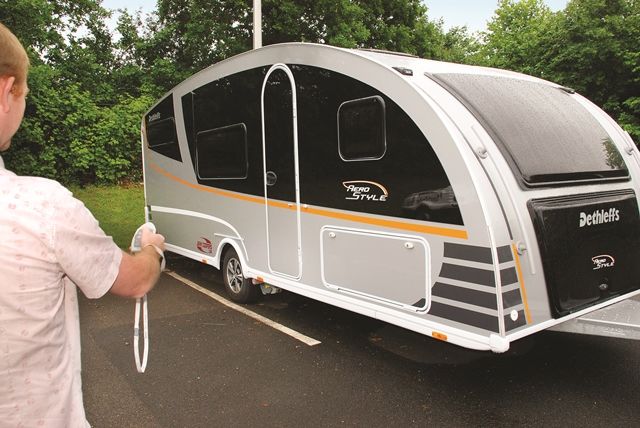
The most popular and generally the most effective type of mover is the axle-mounted type, which consists of a frame bolted to the caravan chassis with a 12V electric motor and roller assembly at each end. Using the caravan leisure battery, the rollers operate against the individual caravan tyres to give full manoeuvrability of the caravan, all operated via a remote control unit. Less common are the type that work at the hitch of the caravan, moving it from the front.
Why buy a motor mover?
There are a number of reasons for installing a mover , these could include:
- Difficult storage location (narrow or steep)
- Ease of pitching on site
- Personal mobility
- Not confident at reversing a trailer
- Trailers and caravans can be difficult to manoeuvre when on a grass or gravel.
There are a multitude of companies offering various motor mover systems at different prices so it's worth asking a few questions to find the right one for you, such as:
- How much will it cost?
- How long is the warranty and what after-sales service is provided?
- Are spares and service agents readily available?
- How much does it weigh?
- How easy is it to use?
- How much will my ground clearance be reduced by?
- Will I need to upgrade my battery to power it?
- Will it affect access to the jacking points and spare wheel?
- Will it cope with the weight of my caravan, especially if it's a twin axle?
We'll also look at other miscellaneous issues associated with motor movers.
Cost
Budget price movers are available but there are many corners that can be cut to reduce costs. Some use a less powerful motor or roller construction, which gives poorer performance, particularly when the tyres are wet and cold. A cheaper cost may also be reflected in poor availability of spares and after sales service, along with a short warranty period. Overall an inferior design may give rise to poor ground clearance and increasing susceptibility to corrosion through a poor paint finish.
Typically companies offer the cross actuation bar (see Ease of Use below) as standard. You will pay extra for electrical engagement of the drive rollers on to the wheels, so do compare like with like and look at the technical specification when considering different cost options.
It's always worth checking up-to-date publication's to see if a manufacturer or dealer has an offer on, as a promotion can make a premium product more affordable.
Warranty
Several companies offer five-year warranties and this could be seen as displaying a manufacturer's confidence in the quality of its product. Other manufactures offer extended warranties for a fee, although this extension may be an insurance-backed warranty, so read the small print before signing. Ask what service is available if you have a problem when away from home and check what is covered under the warranty.
Weight
Remember, the weight of the motor mover comes out of your personal user payload has must be accounted for. The Club suggests a couple is likely to take about 150kg of equipment, so if a caravan has a payload allowance of 180kg a motor mover weighing more than 30kg would take you over the limit. The lightest mover currently available weighs about 27kg. Other systems may weigh up to 40kg, giving an actual payload of 190kg and you would need to remove other user items to be legal and safe. These may be able to be put in the car instead.
If your caravan has a payload of about 200kg you're likely be okay, even with the heaviest mover fitted, but take extra kit for a couple of children and you could be overloading the caravan. So do check your allowable payload and the weight of the mover plus all your other kit onboard. Even if you think you can manage the extra weight, it may be worthwhile visiting a weighbridge after the mover is fitted when the caravan is loaded to check you are within your allowable limit.
Ease of use
There are several ways for the drive rollers to be engaged on to the caravan wheel. Some use a manual over-locking cam device that's quick and you know the roller is fully engaged or disengaged, but requires more effort to put on. Other systems use a screw wind-on action, which is slower and depends on the operator to ensure the roller is fully engaged, this is normally indicated with a green window or pointer. There's also a more expensive electrically-driven engagement system available. If you have difficulty with hand strength it may be worth trying a manual systems before you buy.
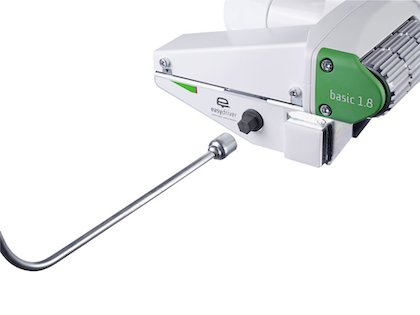
A Manually engaged motorised mover, this type is wound in and out
Most manual systems offer a facility referred to as cross-actuation where the rollers on both sides engage simultaneously by operation from just one side. This is more convenient and is essential if you wish to store your caravan alongside a wall, as it's not recommended to keep a roller pressed against the tyre over a long period of time. The downside of operating both rollers from one side is the extra effort required. The fitting of a cross-actuation bar also increases weight.
Electrical roller engagement is a convenient feature and can be essential for someone with mobility difficulties. It's important to find out what facilities are available to manually engage and disengage the rollers in case the battery or engagement motor fails.
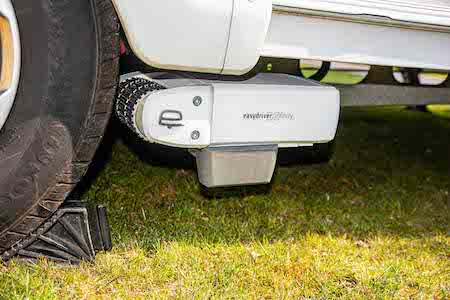
A electrically positioned motor mover drive unit, note the heavy duty roller
A well-engineered roller that grips well in both wet and dry conditions is essential. Look for a strong large diameter, wear-resistant roller with a rough surface that provides the maximum of contact with the caravan wheel. Rollers can be of one piece alloy material with teeth like open gears (see above image) or with a synthetic grit covering. Others are made from steel with milled slots, which are harder and less prone to damage.
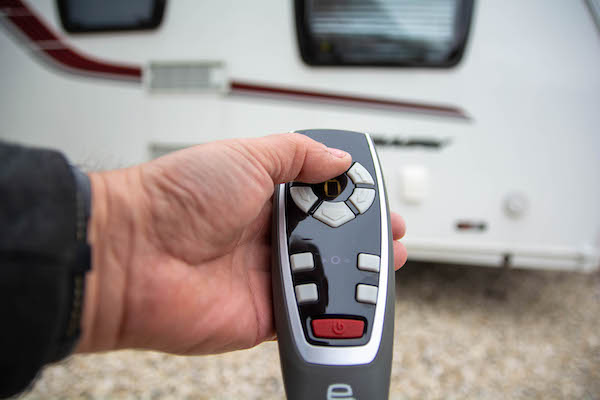
Remote handset controls the positioning and movement of the drive units
All chassis-mounted movers come with a remote control unit like a TV remote control. Some movers come with an alternative cabled connection option for the remote control, which enables the mover to be controlled even when working in areas of high electronic interference.
Soft start and soft stop are facilities offered by many movers and designed to reduce shock loading to the caravan chassis. With simple on/off motors, even a short burst of power may produce sharp movement, giving shock loading to the chassis and also making delicate manoeuvring tricky. Soft start eliminates this by allowing the unit to move off slowly and gives the operator a very high level of control - very useful in narrow entrances and bringing the hitch head over the towball. Soft start with instant stop offers the best level of control for fine positioning.
Ground clearance
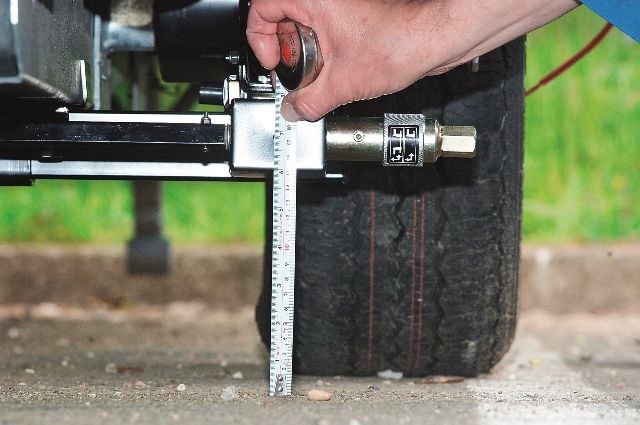
Ground Clearance of 150mm or more is recommended
Good ground clearance is essential. There's no point having a mover fitted if it hits the first road hump it comes to or falls fouls of a deep pothole.
The method of attachment of mover to caravan chassis varies with different makes and each caravan varies, even if with the same chassis. The wheel size may be different, so a mover supplier may not always be able to predict what ground clearance you'll have.
What the supplier will be able to tell you is the maximum depth the mover will hang below the chassis at the point of attachment so you will be able to work out how much ground clearance you have left.
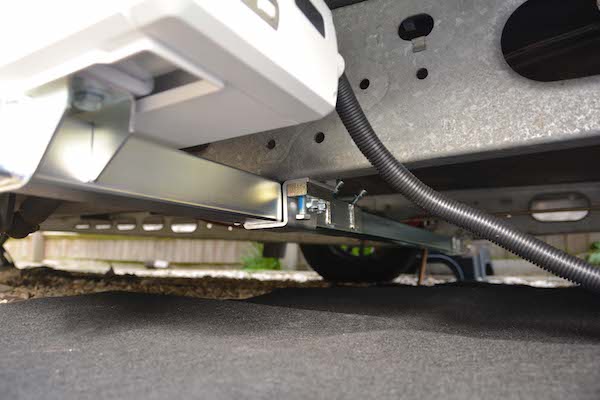
Only the cross member protrudes below the chassis, whilst the drive units seat above the chassis rails
There's a caravan industry standard recommending a minimum chassis ground clearance of 150mm, so a motor mover with a ground clearance less than this is not ideal. More typical clearance is about 30mm below the chassis at the point of fitting.
Battery
Mover manufactures usually recommend a minimum battery capacity for their products, but the capacity will vary with the type of use. A well-charged 85Ah battery in good condition should cope with a long awkward access that will take ten minutes to traverse, but a poorly-charged 110Ah battery after a long weekend away without a hook-up could struggle. A good battery, well maintained, is essential and remember if you need to use the mover extensively to place your caravan into storage you need to consider how you can top the battery back up again. A depleted battery will deteriorate much more quickly than a fully-charged battery.
Restrictions
The fixing of a mover may interfere with the function of the spare wheel carrier or jacking brackets, which generally have a predetermined location behind the axle. Locating the mover forward of the axle will resolve this problem. There's also the possibility of conflict between the mover location and shock absorbers if fitted. Where movers are fitted to both axles of a twin axle caravan there may be no alternative but to carry the spare wheel elsewhere other than in the carrier and accept the proprietary jack bracket mounting points may not be usable. Powrtouch offers a kit to move the AL-KO spare wheel clear, but the jacking points still remain lost. Occasionally, heating ducts or water pipes may need to be relocated to allow room for the mover.
The location of the mover will have an effect on the caravan's noseweight. If fitted in front of the axle the noseweight will be increased slightly and when fitted to the rear of the axle the noseweight will slightly decrease.
Motor mover manufactures should specify a maximum working limit for their product in terms of caravan weight and gradient.
It is important to check that your requirements are within the limits, particularly if you need to operate on a steep gradient.
A motor mover with a quoted maximum caravan weight of 1,800kg may only be capable of moving a 1,200kg caravan on a one-in-four slope.
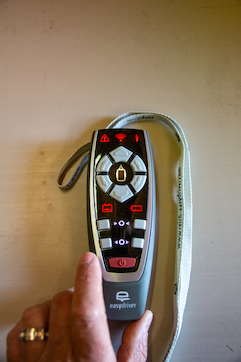
Reich Handset including leisure battery status and signal strength feedback
Recent improvements
The latest generation of motorised movers are lighter and more powerful. Many have app controls as an alternative to a separate handset and they have increased the ground clearance, pulling the motors up on the caravan chassis rails. Some have information fed back to the handset and some are water resistant too.
Twin axles
Twin axle caravans are more difficult to manoeuvre than caravans with single axles. That means a special approach is needed when fitting a motor mover to a twin axle caravan.
The less expensive option is to fit motors to either the front or the rear axle and operate the system with the jockey wheel raised or lowered to keep the load on the driven axle. Note that a twin axle caravan will not turn almost on the spot like a single axle caravan but turns along a curve, as if being towed. How tight the radius of the curve is will depend on the performance of the selected mover and the surface conditions. There may be situations when uneven ground could leave one or more of the drive wheels off the ground and some twin axle caravans may be too heavy for a single pair of mover motors.
Better manoeuvrability may be obtained by fitting motors to both axles. The downside of this arrangement is the financial cost and extra weight. A twin axle caravan may have a generous payload allowance, but a full set of movers to both axles could take up as much as 80kg of this payload.
Special applications
Axle movers are engineered to clamp on to modern AL-KO and BPW chassis without any drilling, which is not permitted by the chassis manufactures as it would weaken the chassis.
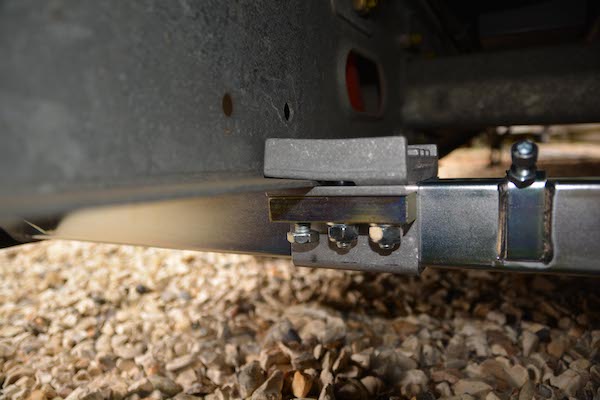
Typical clamping system for the motor mover that requires no drilling of the chassis
Other caravans such as early Lunar models with an alloy Knott chassis or specialist makes of caravans like Eriba and Gober may need additional brackets to facilitate the mover installation. For such specialist caravans you will need to consult the mover manufacturer.
Once installed, a motor mover should allow many years of use and most are capable of being removed and remounted on a new caravan subject to the weight being within the mover's weight limit. It's at this stage when the value of stainless steel fixings and good quality paint finishes show.
Motor movers undoubtedly remove a lot of hard manual work from caravanning but some things need to be borne in mind about their use to avoid damage to the caravan chassis.
The motors are very powerful so do ensure there's nothing in the way of the caravan and don't forget to take the handbrake off. It's important to put the handbrake back on before disengaging the rollers unless you have chocked the wheels or you are completely satisfied the ground is flat.
Guiding the caravan by remote control is effortless and thus it's easy to overlook minor features on the ground that can cause problems. A jockey wheel bogged down in soft ground, shingle or chocked by a stone or bumper kerb can cause great stress on the caravan chassis and often the first symptom is a bent jockey wheel.
It is best to use a heavy duty jockey wheel, preferably with a pneumatic tyre and if possible a jockey wheel with some form of suspension (the noseweight gauge type).
Don't neglect your mover, follow the mover manufacturer's maintenance instructions and ensure the required checks and lubrication are included on the service schedule when you take your caravan in for service.
The original motorised caravan mover were self-contained devices that attach to the hitch or jockey wheel bracket and the motor powers small wheels with the power coming from the caravan's leisure battery or its own battery. Manoeuvring is usually undertaken with the aid of a long handle attached to the unit.
Not being permanently attached to the caravan means the available payload is not reduced. Such units are designed for use at one site and are not really for taking with you because of their weight and bulk. So if your main problem is with manoeuvring your caravan in and out of the storage at home this could be an option.
There are several disadvantages with this type of mover. As the steering and power controls are located on the steering handle at the front of the unit, when reversing a caravan you may need an assistant to guide you. A far bigger problem with a hitch mover is the poor traction experienced, particularly on gravel and soft ground. This isn't surprising considering the size of tyres and the small contact area with the ground and limited weight on the tyre.
Some movers can be supplied with special tyres to help where softer ground is to be encountered but they're not always successful depending on your exact conditions. Some companies offer to demonstrate at your home or sell on a sale or return basis.
Be cautious before using a hitch mover that operates by replacing your normal jockey wheel. AL-KO, the manufacturer of chassis for about 85 per cent of the UK's caravans, does not recommend the drive being taken through the jockey wheel.
However, on relatively flat and hard surfaces, hitch- and jockey-mounted movers can prove very successful. Jockey mounted movers do have an advantage over hitch-mounted movers for turning twin axle caravans as the hitch can be raised to reduce the load on the caravan's front axle.
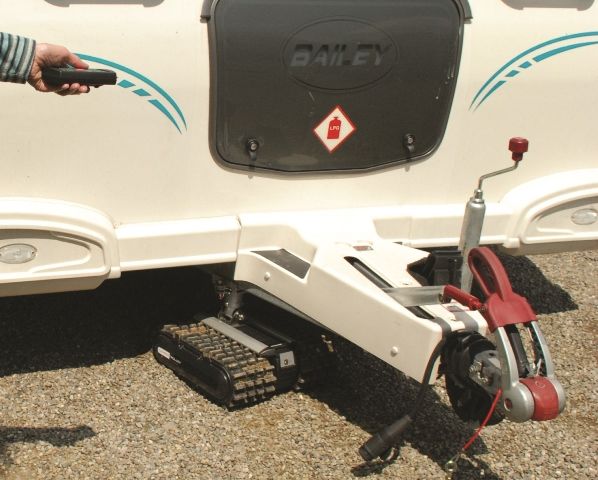 Another version of a hitch mover is Pro-Tec's compact demountable mover pictured above that fits to a pre-installed fixing on the caravan's A-frame. This mover has its own lithium ion battery, runs on rubber continuous tracks and is operated by remote control. It may be of use where there is limited payload available for a traditional motor mover as this unit is light and easy enough to remove and can be transported in the towcar.
Another version of a hitch mover is Pro-Tec's compact demountable mover pictured above that fits to a pre-installed fixing on the caravan's A-frame. This mover has its own lithium ion battery, runs on rubber continuous tracks and is operated by remote control. It may be of use where there is limited payload available for a traditional motor mover as this unit is light and easy enough to remove and can be transported in the towcar.
And finally...
The National Caravan Council has a Code of Practice (305) for the design specification and installation of motorised movers. It is specifically aimed at caravans but would be equally suited to other trailer based products like a folding camper. This CoP ensures the mover meets certain requirements such as tackling a 18% gradient both up and down hill and providing a fuse and isolation switch for the movers power supply. So it is worthwhile asking prior to purchase if the CoP is being followed. If this is the case the installer should provide a check list and declaration
of compliance.
If you have feedback on our new format Data Sheet, please let us know, using our short Feedback Form.